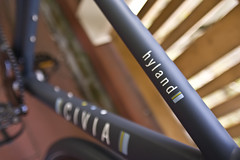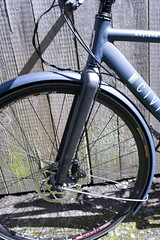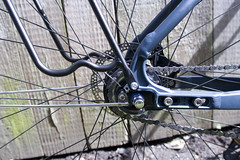 The Civia Hyland is the perfect bike for someone who wants a bike to get where they’re going in a one-stop, high performance package, provided you’ve got the cash to back your desires. Civia’s paid meticulous attention to a huge number of details to get things just right – the frame, the ride, the look, and the componentry. The Hyland’s not without any flaws of course, but for those looking to drive a luxury ride off the lot tonite this might just be the ticket. See our previous coverage here, and here. Check inside for more details and photos via the Bikehugger urban bike pool. Note: We’ve recieved some feedback asking for a more forthcoming review, so I’ve added in a few additional notes, leaving the original text in place.
The Civia Hyland is the perfect bike for someone who wants a bike to get where they’re going in a one-stop, high performance package, provided you’ve got the cash to back your desires. Civia’s paid meticulous attention to a huge number of details to get things just right – the frame, the ride, the look, and the componentry. The Hyland’s not without any flaws of course, but for those looking to drive a luxury ride off the lot tonite this might just be the ticket. See our previous coverage here, and here. Check inside for more details and photos via the Bikehugger urban bike pool. Note: We’ve recieved some feedback asking for a more forthcoming review, so I’ve added in a few additional notes, leaving the original text in place.
 I’ve seen all kinds of tube shapes over the years, but the recessed cable routing channels are a first for me. The channels help keep the bike very clean looking – both because the cables are out of view and because you can move the cables aside to wipe down the frame when it gets dirty. Keeping the cables out of view gets you a long way towards a simple appearance – not quite a singlespeed, but not far from it. The rest of the frame gets high marks: great looking welds on the 7000 series aluminium tubing, clearance for wide tires (up to 35 mm!), post mounts for disc brakes.
I’ve seen all kinds of tube shapes over the years, but the recessed cable routing channels are a first for me. The channels help keep the bike very clean looking – both because the cables are out of view and because you can move the cables aside to wipe down the frame when it gets dirty. Keeping the cables out of view gets you a long way towards a simple appearance – not quite a singlespeed, but not far from it. The rest of the frame gets high marks: great looking welds on the 7000 series aluminium tubing, clearance for wide tires (up to 35 mm!), post mounts for disc brakes.
 Also: the incredible sliding dropouts. A typical vertical dropout can accommodate a derailleur setup but won’t let you set up for internally geared hubs without a chain tensioner. The Hyland’s sliding dropouts let the builder choose traditional derailleur, Shimano Alfine internally geared hub, or the Rolls Royce of internally geared hubs: the 14 speed Rholoff. Such flexibility is hard to find in frame designs, and accommodating IG hubs can often mean expensive detours such as eccentric bottom brackets.
Also: the incredible sliding dropouts. A typical vertical dropout can accommodate a derailleur setup but won’t let you set up for internally geared hubs without a chain tensioner. The Hyland’s sliding dropouts let the builder choose traditional derailleur, Shimano Alfine internally geared hub, or the Rolls Royce of internally geared hubs: the 14 speed Rholoff. Such flexibility is hard to find in frame designs, and accommodating IG hubs can often mean expensive detours such as eccentric bottom brackets.
The frame’s very stiff and solid, and when I put my foot down this ride goes – no lag, just go. Low lateral flex plays a big part I’m sure, and the overbuilt frame pays off well here. The handling’s predictable and stable. The ride is solid as well but the carbon forks and wide tires help take the edge off. Even with this help the Hyland rides pretty rough, with a bit more ‘road feel’ that seems really necessary.
 It’s clear from the first glance that Civia put a lot of thought into the appearance of the bike. The clean cable routing is just one aspect. The paint’s pretty incredible – the matt, dark colors are very attractive (almost velvety) without calling too much attention to itself, maybe making it just a bit safer when locked up on the street corner. The matching fenders are a very nice touch. The drive train on the Alfine equipped bike I rode has all the simplicity and visual elegance of singlespeed drive trains. The swept back flat bars are a bit unfortunate here – there are lots of very attractive alternatives on the market right now and the flat bars say ‘hybrid’ as loudly as the Honda Insight.
It’s clear from the first glance that Civia put a lot of thought into the appearance of the bike. The clean cable routing is just one aspect. The paint’s pretty incredible – the matt, dark colors are very attractive (almost velvety) without calling too much attention to itself, maybe making it just a bit safer when locked up on the street corner. The matching fenders are a very nice touch. The drive train on the Alfine equipped bike I rode has all the simplicity and visual elegance of singlespeed drive trains. The swept back flat bars are a bit unfortunate here – there are lots of very attractive alternatives on the market right now and the flat bars say ‘hybrid’ as loudly as the Honda Insight.
The componentry on these bikes is top notch. My only componetry complaint is with the hubs and wheels. I was hoping the Alfine hub would be free of some of the quirks that my nexus equiped bike shows, but I still get the ‘spinning up’ feeling on my first pedal stroke and of course the entirely different set of noises that an IG hub provides as opposed to your regular old freehub. The wheels I rode seemed like they were still tension-releasing during my short time, which can be a scary sound if you’re not used to it. On the other hand the Alfine group I rode was very nice. Hydraulic stoppers that never quit stopping; the internally geared hub shifts very well – even compared to other IG hubs. But the goodness doesn’t stop there – nice wide 28mm Panaracer T-servs with a nice reflective stripe and a built in flat protection belt, a custom rack with a spot for a tail light, a very good saddle, very nice Thompson machined stem, ODI grips, and my favorite component of all – generator driven front light, with plenty of light for night riding.
Here’s where Civia plays it’s hand: the Hyland’s the get me where I’m going bike that comes with (almost) everything you need. This stuff isn’t impossible to get, you can get it on any bike you like provided you’re willing to wait out the delivery or piece it together yourself as time permits. At almost $2k you’re paying a premium price for a premium bike, but as gasoline goes up the cost of a get me around the city day or night, rain or shine bike seems more and more reasonable. This bike targets the luxury car crowd who can drop a couple of Gs on the best bike. If this is you, I can’t wait for you to get the Hyland (and quit riding my tail in your Lexus).
What would I change? A stand light included on the front – it’s critical that riders be seen when stopped. Get yourself a backup front light until Civia adds one in. Also, I’m surprised Civia didn’t include a rear light, generator driven or not. A bell or a honka hoota would be a nice touch too, but I can imagine everybody will want to pick their own. I wasn’t thrilled with the flat, back-swept bars, I’m more of a riser bar guy myself. One last note – check to ensure your feet clear the fenders when turning, especially on the smaller sizes. I had a bit of toe-strike on the 52, I hear it’s not a problem on larger models.
All in all I expect to see quite a few Hyland’s on the road in the near future. A friend of mine spent most of the winter waiting to start bike commuting while the Local Bike Store got her outfitted with what she needed. The Civia’s 95% ready to ride on a rainy winter night, and the other 5% you can get where you get your bike. The $2k price tag on the Alfine equipped ride would be pretty steep for a feature-free hybrid bike, but it looks cheaper every time I ride past the gas station. I think bikes like this will give folks the peace of mind they’ll need to take the plunge into bicycle commuting.
…We're riding townies, adventure, and mountain bikes. Find recommendations on our store page. As Amazon Associates we earn from qualifying purchases.